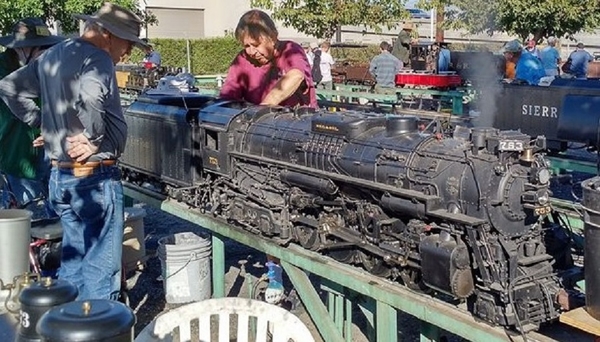To answer the questions I think you're posing, no, there's really isn't any kind of "operator's manual" for a steam locomotive. While the basic controls are essentially the same (throttle, some type of reverse gear arrangement (whether it's a Johnson Bar, power reverse, wheel), brakes, etc.), each engine will be slightly different. Larger engines might have feedwater heaters; smaller engines might only use injectors.
Larger engines with lots of valves sometimes aren't as confusing as they may seem. For instance, on stoker-fired coal burners, you'd often see a cluster of five valves on the backhead. But those five valves were simply the steam jets to distribute the coal to various areas of the firebox.
Sometimes the various valves would have labels, so again, a lot of times the maze of gauges and valves isn't as confusing as it initially seems.
While there weren't operator's manuals per-se, there were text books available that would explain the theory behind the procedures. For instance, the ICS book on oil-firing would explain different burner designs; the properties of the different grades of oils; the need for firebrick; the benefits of oil over coal, etc.
Most of the information on start-up, firing and running is simply handed down from experienced crew to inexperience crew. It's on-the-job training, so to speak. But some of it is just intuition. Was there an instruction manual that explained to you how to start a charcoal fire in your grill? I imagine you already know the basics--your fire needs oxygen and a heat source. So you open the damper and open the lid, add some lighter fluid and light your coal.
When I started on an oil burner, you sort of were expected to know some things, like knowing to remove the stack cap before you started a fire. But the basic sequence was still taught: How to attach the Chicago fitting to the air line. How to start the air compressor. How to clear condensate out of the blower and atomizer lines. How to, once cleared of water, open the blower to clear out any explosive fuel vapors that may have accumulated in the firebox. Making sure you had oil flow through the burner by dribbling some fuel onto the firepan. Spraying PB Blaster on a piece of cardboard (or using diesel on the cardboard), lighting it and lofting it into the firebox just in front of the burner (we could use the oil tank dip stick to position it better), Then applying atomizer and opening the fuel valve until the fire lit.
After that, as others mentioned, you wait until you get enough pressure on the gauge to switch over from air to steam. So you oil around. BS with the guys. Put sand in the sand domes. BS with the guys. Add fuel to the tank. BS with the guys. Top off the water. BS with the guys. You get it.
Once you had some pressure (between 5 and 10 pounds should do it) , you could switch off the air. You turn off the atomizer, letting a burning puddle of oil pool on the firepan. Turn off the blower. Shut off the compressor and disconnect the air line. Close the valve to the tank heater. Open the main header valve; allowing steam to your manifold. Turn on the blower, turn on atomizer (where more condensate is spit through the burner), and open the fuel valve. The atomized fuel will ignite from the burning puddle of oil. Wait for pressure to build to the point you can operate/test the injectors, oil and start the air brake compressor (slowly! You want those moving parts to warm and become lubricated); eventually close the condensate lines.
With running, it's also a lot of OJT, with an experienced engineer next to you, giving instructions. You understand the basics, but there's still a lot going on, and it's still new to you. You don't have any muscle memory for what you're doing. You blow the whistle two times, put the Johnson bar in forward, open the cylinder cocks, and pull out the throttle a bit. You hear hissing, but there's no movement. You pull more throttle. Still no movement. Oops! You forgot to release the brakes. You do that, and the train starts moving. You close they cylinder cocks. You're picking up speed, and need to slow down. You apply a few pounds of reduction to the train brake. But when you do that, the engine brakes apply as well. You need to bail off on the independent brake to release them. You know to hook up, so you do that. You need to slow down again, and apply the train brakes. You push the lever a little too far, and go into emergency. They tell you everyone does it, but you don't feel any better. Now you have to sit and wait while the train line gets pumped up.
Going over a trestle, the training engineer will tell you not to touch the throttle while going over it. When you get to the other side, he'll tell you to pull out the throttle--we're at the start of a long up-grade. Don't forget to blow the whistle at the crossings. Don't start your sequence too soon, or you'll have to do some extra blowing to make it onto the crossing...
Bottom line, with both firing and running, there are books, but no real instruction manuals. Each engine is different; each engine fires and operates with its own little quirks. You learn your position from those who've gone before, and each of those folks may explain how to do things in slightly different ways. You take all their advice and instruction, extract the techniques that work best for you, and after you master your position, you start training the next guys on the ladder.
![]() .
.





